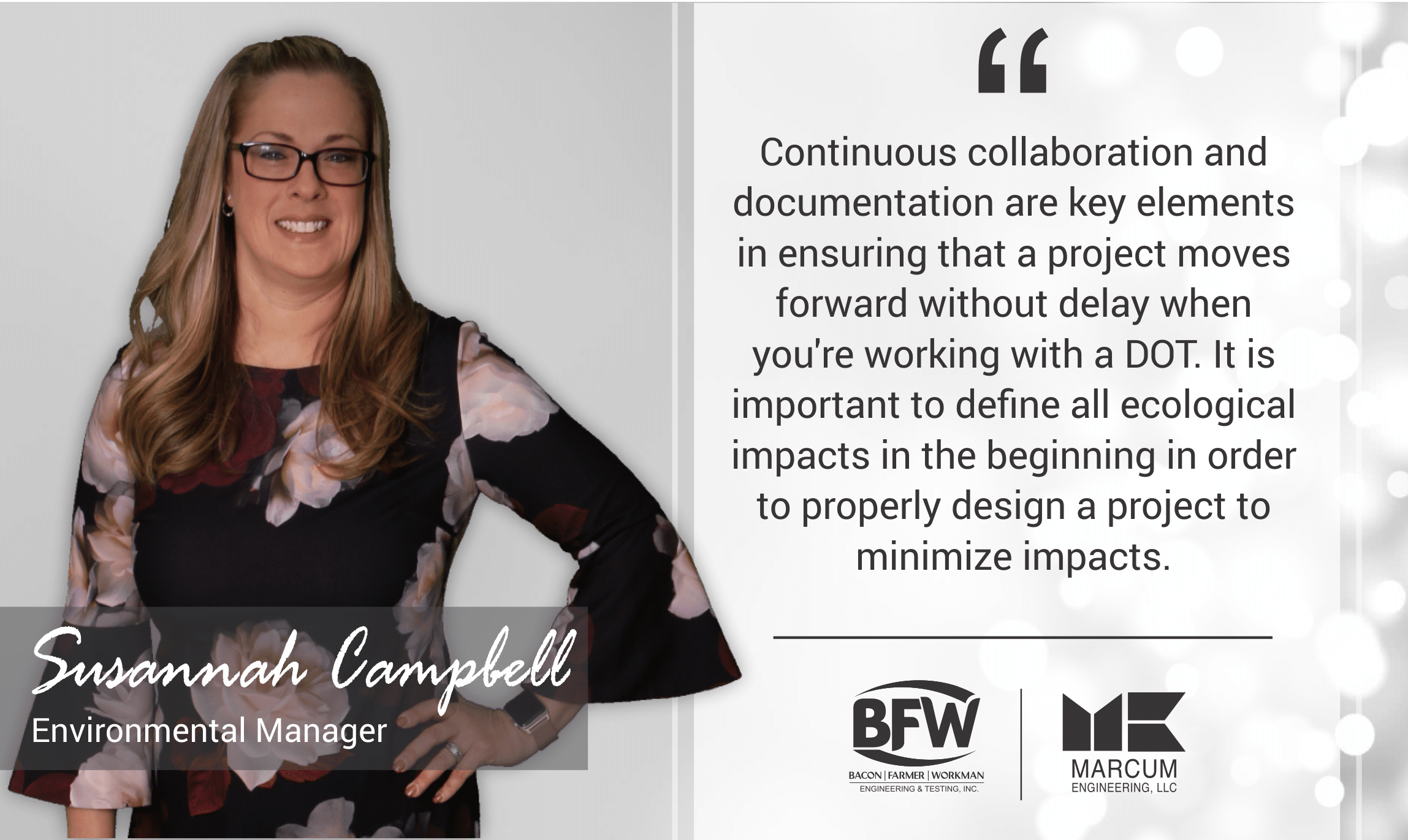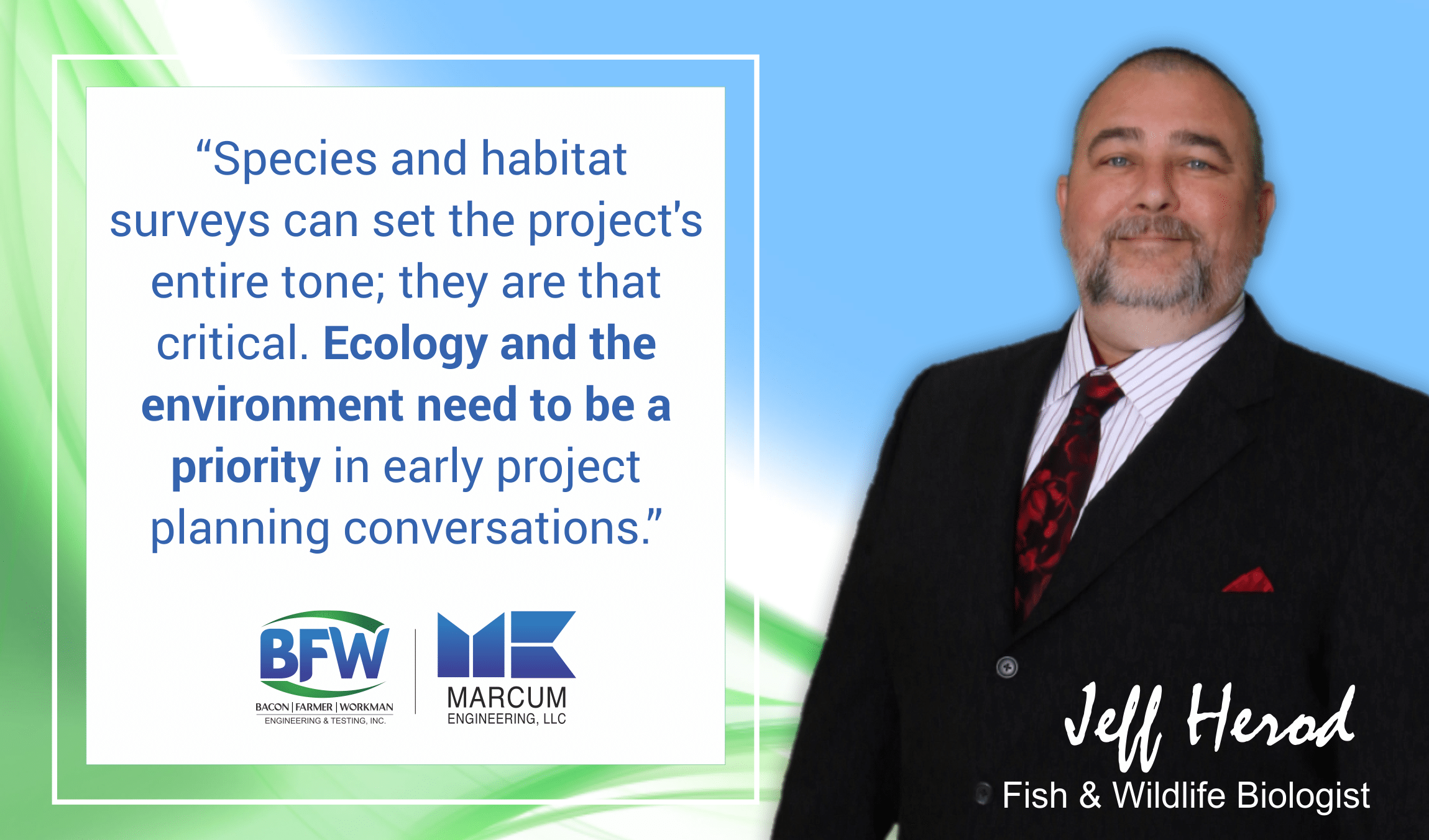Our newest multi-part series is all about transportation engineering from an environmental point-of-view. While it’s one thing to expound on the process of designing a transportation project, we’d like to shed light on the environmental concerns of such complex projects.
At BFW/Marcum, we’re proud to not just have a team that is unanimously concerned with the impact our engineering has on the environment, but an actual in-house team whose job is to take the concern and ensure its oversight is built into our process. We asked them to share their expertise with us. In this piece, we’ll talk about the ecological impact of a transportation job, what we do to minimize it, and how this works seamlessly to build our relationship with our regional state departments of transportation.
From the Office
You’ll know Susannah Campbell’s name as you grow familiar with this series. She’s the Environmental Manager at BFW/Marcum and provides firsthand experience in overseeing how we impact the environment in our work. We first asked her about her favorite thing (note the sarcasm): paperwork.
“Documentation of our ecological oversight is a long process. It involves field studies and then follow up reporting. In addition, many times multiple field reports must be combined into a larger summary report that outlines all of the potential ecological impacts related to a specific project.”

Susannah notes that documentation is especially important when coordinating with a state department of transportation (DOT). “Continuous collaboration and documentation are key elements in ensuring that a project moves forward without delay when you’re working with a DOT. It is important to define all ecological impacts in the beginning in order to properly design a project to minimize impacts.”
To put it simply, state departments don’t mess around. You better be good at crossing your T’s and dotting your I’s.
To the Field
Jeff Herod, Fish & Wildlife Biologist, is the field lead that dots and crosses those letters. As Susannah said, documentation is incredibly important. Most of our data is collected via surveys, which Jeff is no stranger to.
“Surveys are relevant to transportation because the areas that are to be used typically require permits to develop and the application process for those permits requires information about the condition of the environment and what species and habitats are presently in the environment. In general, there is an office and field component to these surveys.”
Jeff breaks our survey scope into three main categories, which come together to give us a clear picture of an area’s biome.
Water Quality
“We do desktop surveys of databases to identify the presence or absence of streams, wetlands, and what types of soils are present which is then followed up with a site visit. During the site visit we will measure water chemistry such as temperature and pH. While onsite we will assess and describe the characteristics of any streams present.
The stream assessment includes describing the stream width, land use around the stream, features in the stream (pools, riffles, and runs), stream depth, and instream habitat/cover available in the stream.
This assessment provides a description of the stream quality to the designated regulatory agency for review.”
Habitat
“We do more desktop surveys of databases to identify wildlife and plant habitat. We query the US Fish and Wildlife Service database named IPaC, which provides a list of federally-listed species’ and their presence-absence for the proposed project site. During the site visit we can assess species and habitats. Sometimes a site might be within a species’ range but the species is absent or the species’ specific habitat is simply not present.
The key info is “species present” and “critical habitat”. This information determines the types of surveys required, the types of areas within the project area to focus more intensive surveys, and what types of habitat characteristics to focus on.”
Wetlands
Via a desk top survey of databases, we identify information related to wetlands. We query databases about streams, soils, and known wetlands within a project boundary.
The next step is to conduct a site visit. During the site visit, we go to areas suspected to be wetlands and collect information on hydrology, soils, and plants within the area. This information allows us to determine whether the area is a wetland. If it is a wetland, we then look to delineate the boundary of the wetland.”
Species, Habitat, & Ecology Set the Tone
Jeff continues to explain the importance of surveying before doing anything else. “Species and habitat surveys can set the project’s entire tone; they are that critical. Ecology and the environment need to be a priority in early project planning conversations.

In my opinion, most projects can accommodate species, habitats, and our community needs. Some project proponents want to avoid the cost of mitigation and will alter the design to avoid, or at least minimize impacts. This is the intention of most environmental laws. These laws were not intended to stop projects, but to hold projects to a standard.
If environmental studies and surveys are implemented early in the project planning stage, the information can be invaluable in cost savings and during project design. The environmental work can provide the framework for the landscape, species, and regulatory processes required. Likewise, it could provide a clear path for less environmental regulation if the design and planning stages incorporate environmental recommendations such as avoidance and minimization measures.
I previously worked on a project where the design was changed to avoid impacting federally listed freshwater mussels. In this particular case, the best outcome was to adjust the project to avoid environmental impacts which protected the endangered species and saved the project money since hefty mitigation fees were avoided. The final project was located in a better environment and ultimately served the community to make it healthier.”
Working with States Departments Means High Commitment & High Reward
Not just anyone can throw their hat in and send a proposal to a state department of transportation. You need to appease the requirements they set forth (there are more than a few) and have an in-house dedication to environmental sustainability. Susannah is one of our best advocates in this arena. She understands that decades of learning, strategic hiring, and culture go into a winning proposal.
“When applying for a DOT project, there are very specific job requirements that are requested during the initial phases of firm selection. These include capacity, labor skills, resources, past experience, and the ability to meet hard deadlines as required for transportation standards. Much time is spent preparing similar project scopes which outline firm capabilities in order to make the selection cuts when DOT awards task orders.
Preserving ecological balance while not impeding development is of special interest to DOTs. After all, ecological balance is important because it leads to the continuous existence of organisms. It is important that the standard is met and kept to ensure future protection of precious resources.
Preserving ecology can be very costly. I think it takes proper planning and development in order to ensure that ecological resources are protected and that future development is allowed to progress.”
In other words, taking the time to care about the environmental at any level can cost money. Having the hard-won experience, intuition, and in-house skills to do this while maintaining a budget is something akin to an art form. We’ve worked for decades to be where we are today; a trusted firm that works hand-in-hand with state departments.

Recent Comments